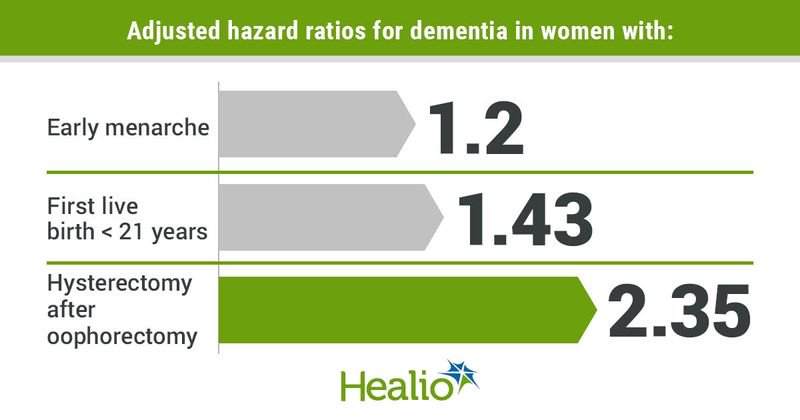Study shows certain reproductive factors increase dementia risk in women
Younger or older age at menarche, younger age at first birth, and hysterectomy — all of which affect lifetime exposure to endogenous estrogen — were associated with a higher risk for dementia in women, researchers found.
They also determined that the association between the number of children and dementia was similar in women and men.

The findings are important as studies have shown that the prevalence and death rates for dementia are higher among women than men.
“While the risk of developing dementia increases with age, the extent to which the female predominance is simply due to women’s longer life span remains far from conclusive, and female-specific reproductive factors may be able to explain these sex disparities,” Jessica Gong, MSc, a PhD candidate at The George Institute for Global Health, University of New South Wales, in Sydney, Australia, and colleagues wrote.
“Several endogenous estrogen changes occur throughout a woman’s reproductive life,” they added. “Estradiol is the most predominant form of estrogen during reproductive life (from menarche to menopause), and estriol is the primary estrogen during pregnancy. Exogenous hormone use, such as oral contraceptives during reproductive years, and hormone replacement therapy (HRT) in later life can also influence estrogen level.”
UK Biobank data
Gong and colleagues analyzed the data of 273,240 women and 228,957 men without dementia who were enrolled in the U.K. Biobank — a prospective population-based cohort — between 2006 and 2010. They assessed participants’ follow-up data from baseline until incidence of all-cause dementia, death or until the cutoff on Nov. 30, 2020.
Women self-reported reproductive factors that would affect endogenous estrogen exposure — such as age at menarche, pregnancy history and hysterectomy — and exogenous hormone exposures.
For all participants, researchers analyzed social deprivation — including employment status, car ownership, household overcrowding and owner occupation — and the number of children a person had.
Endogenous factors
Over a median follow-up of 11.8 years, 1,866 women and 2,202 men had incident dementia.
Compared with women who reached menarche at 13 years of age, the risk for dementia was significantly greater in those who reached menarche before age 12 years (adjusted HR = 1.2; 95% CI, 1.08-1.34) and after age 14 years (aHR = 1.19; 95% CI, 1.07-1.34). The risk for dementia was also significantly greater in women who were aged younger than 21 years at first live birth compared with those aged 25 to 26 years (aHR = 1.43; 95% CI, 1.26-1.62).
Hysterectomy also increased the risk for dementia (aHR = 1.12; 95% CI, 1.01-1.25). Of note, women who reported hysterectomy after oophorectomy were significantly more likely to have dementia compared with those who reported neither (aHR = 2.35; 95% CI, 1.06-5.23).
Assessing by socioeconomic status (SES), hysterectomy (aHR = 1.31; 95% CI, 1.09-1.59) and oophorectomy (aHR = 1.39; 95% CI, 1.08-1.78) were associated with a higher risk for dementia among women of lower SES only.
There was a lower risk for dementia with pregnancy (aHR = 0.85; 95% CI, 0.74-0.98), each abortion a woman had (aHR = 0.82; 95% CI, 0.71-0.94) and a reproductive span 36 years or longer, Gong and colleagues found.
Additionally, women who experienced menopause before 47 years of age had a greater risk for dementia compared with those who reached menopause at age 50 years (aHR = 1.32; 95% CI, 1.15-1.51).
Exogenous factors
The researchers also found that oral contraceptive pill use was associated with a lower risk for dementia (aHR = 0.8; 95% CI, 0.72-0.88).
There was no significant difference in dementia risk between women who used HRT or not (aHR = 0.99; 95% CI, 0.9-1.09), or for HRT duration (aHR = 1; 95% CI, 0.98-1.01). However, there was a small reduction in dementia risk with older age at HRT initiation (aHR = 0.96; 95% CI, 0.95-0.98).
Compared with people who had two children, the association between the number of children born or fathered and dementia was similar between men and women.
“This study highlights that the reproductive and endocrine milieu in women may be involved in dementia risk, although the physical experience of childbearing is unlikely to account for the risk variation in women, given the similar associations observed for number of children and dementia in women and men,” Gong and colleagues wrote.
Moving forward, they suggested clinicians should address dementia prevention throughout the life course. They also said studies should further examine exogenous hormone use and social deprivation.
“It is necessary to validate our findings on exogenous hormone use through rigorous clinical trials, and our findings may be helpful for identifying high-risk women to participate in future trials. Further, social deprivation is likely to be an important determinant of dementia risk and other aspects of women’s health, given that the elevated dementia risk associated with early (natural and artificial) menopause were more strongly associated with dementia in women of lower SES.”


